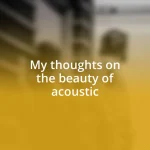Key takeaways:
- Classical music’s origins, rooted in Western traditions and influenced by historical and folk contexts, connect personal experiences to musical expression.
- Engaging with influential composers like Bach, Beethoven, and Tchaikovsky highlights the emotional depth and innovation within classical music, showcasing its diverse expressions.
- Experiencing live performances and creating curated playlists deepens appreciation for classical music, making it a personal soundtrack that resonates with individual memories and emotions.

Understanding classical music origins
Classical music has its roots in the rich tapestry of Western musical traditions that began in the Middle Ages and evolved through various periods, including the Renaissance, Baroque, Classical, Romantic, and Modern. When I first learned about these distinct periods, I couldn’t help but wonder how each composer’s life experiences influenced their music. It’s fascinating to see how historical events, cultural shifts, and individual struggles reflect in the melodies and structures of their compositions.
As I delved deeper, I discovered that the emergence of written music in the 9th century was a huge turning point. It allowed composers to not only share their works with others but also to explore more complex musical ideas. I remember feeling a sense of awe when I realized that some of the music I cherished had its origins in a time when notation was just being developed. The idea that what I listen to today has ties to centuries-old traditions gives classical music an almost timeless quality.
A pivotal moment in understanding classical music’s origins for me was learning about the influence of folk traditions on classical compositions. It made me think—how is it that music evolves yet still retains the essence of its roots? For instance, composers like Bartók and Brahms drew inspiration from the folk songs of their cultures, which connected deeply with my own experiences of hearing family stories intertwined with music. This blend of history and personal narrative in classical music truly enriches my listening experience, making each piece feel both ancient and personal.

Discovering influential composers
As I started to explore classical music, the names of influential composers captivated my curiosity. Learning about figures like Bach, Beethoven, and Mozart brought a sense of historical connection. I remember sitting at my piano, playing a simple piece by Chopin and imagining the world he lived in—how his struggles and triumphs shaped his expressive melodies. Their stories resonate with me, illuminating the human experience behind the music.
With each composer, I unearthed layers of innovation and emotion. For instance, I was struck by how Tchaikovsky’s personal life influenced his passionate compositions. A particular moment that stands out was listening to “Swan Lake” for the first time; I could feel the pain and beauty he poured into those notes. It made me reflect on how music can articulate feelings that words sometimes fail to express, a realization that has deepened my appreciation for classical works.
Compiling my thoughts about these composers led me to realize just how vast their impact is. Each composer brought something unique to the table; for example, the mathematical precision of Bach’s structures compared to the emotional fervor of Brahms’ symphonies. This contrast prompted me to ask: How does a single genre encompass such diverse expressions? I found joy in recognizing that classical music, while rooted in tradition, is anything but monolithic, capturing the myriad shades of human emotion and experience across generations.
| Composer | Influence |
|---|---|
| Bach | Mathematical precision and counterpoint |
| Beethoven | Pioneering the transition to Romanticism |
| Mozart | Melodic genius and operatic innovation |
| Tchaikovsky | Emotional depth and ballet integration |
| Brahms | Romantic expressiveness with classical foundations |
| Bartók | Folk traditions and innovative forms |

Exploring different classical music genres
Exploring the various genres within classical music opened my eyes to a whole universe of styles and emotions that I never knew existed. Each genre has its own distinct character, and I found myself gravitating toward certain styles based on how they resonated with my personal feelings. For example, when I first listened to a Baroque piece by Vivaldi, the vibrant rhythms and elaborate ornamentation transported me to another time. The energy and complexity felt almost like a conversation between instruments, and I couldn’t help but sway along to the rhythm.
Here are some key classical music genres I’ve come to appreciate:
- Baroque: Known for its ornate style and complex counterpoint, exemplified in the works of Bach and Vivaldi.
- Classical: Characterized by clarity and balance, with composers like Mozart creating works with elegant melodies and forms.
- Romantic: This genre is deeply emotional, featuring composers like Tchaikovsky and Brahms, who infused their pieces with personal passion and expressiveness.
- Modern: Often breaking traditional forms, composers like Stravinsky pushed boundaries, incorporating dissonance and unique rhythms that captivated my curiosity.
- Opera: An intimate blend of storytelling and music, where the dramatic arias of composers like Verdi left me in awe of the human voice’s capacity for emotion.
As I transitioned into contemporary classical music, I discovered how composers often reinterpret traditional forms, revealing the genre’s vastness. I remember being captivated by a modern composition that incorporated electronic elements alongside traditional instruments; it felt fresh yet connected to the past. This juxtaposition made me wonder how these evolving genres would continue to shape the future of music. Ultimately, diving into these genres has enriched my appreciation for classical music, as each piece serves as a bridge between the past and my own experiences.

Attending live classical music events
Attending live classical music events has been a game-changer in my relationship with this genre. I vividly recall the first time I sat in a grand concert hall, the hushed anticipation vibrating in the air. As the orchestra began to play, I was enveloped in sound; it felt as though the music was painting vivid images in my mind. The experience is wholly different from listening to recordings—there’s something magical about feeling the vibrations resonate through your body.
I can’t help but reflect on the emotions that wash over you when you’re in the presence of live musicians. During a particularly memorable performance of Beethoven’s Ninth Symphony, I was struck by the sheer power of the choir’s voices joining the orchestra. The “Ode to Joy” was not just music; it became a collective celebration of humanity, and I found myself swept up in its exuberance, sharing that moment with strangers who became temporary friends in that space. How often do we get to feel such unity and joy in everyday life?
The intimacy of live concerts also allows me to connect with pieces on a deeper level. I remember attending a chamber music event where I could see the musicians’ expressions—how their faces lit up during crescendos or tensed during softer passages. That intimacy made the performance feel like a shared conversation, and I wondered: how can something so profoundly expressive come from just a few instruments? Experiencing classical music live has opened my eyes to nuances I never would have noticed otherwise, transforming my understanding and appreciation for the art form.

Listening to classical music playlists
Listening to curated classical music playlists has become one of my favorite avenues to explore this genre. I remember building a collection of playlists for different moods; one for focus, another for relaxation, and a third for inspiration. There’s something magical about hitting play and allowing the music to wash over me, transforming the atmosphere around me. Have you ever noticed how a particular piece can perfectly match a moment? I find that certain compositions can elevate the simplest tasks.
One unforgettable playlist included Debussy’s “Clair de Lune.” The gentle piano notes felt like a soft embrace when I was working on late-night projects. The way the music ebbed and flowed became both a soothing balm and a source of motivation, helping me channel my thoughts into creativity. Creating playlists allows me to connect to classical music not just as a listener, but as a curator of experiences. Each selection becomes a personal soundtrack, anchoring memories to specific pieces and emotions.
I also love discovering themed playlists, like those inspired by seasons or specific feelings. When autumn arrives, I turn on a playlist filled with melancholic works by Chopin, each piece echoing the beauty of falling leaves. It’s as though the music becomes a mirror reflecting my inner world. Listening to these playlists invites me to share stories and emotions that I want to connect with, making the experience dynamic and profoundly personal. How do you engage with music in your daily life? I believe that, by intentionally creating soundscapes, we can bring deeper meaning to our everyday moments.

Learning about musical instruments
Learning about musical instruments has been an eye-opening journey for me. I remember visiting an instrument exhibit at a local museum where I could see and touch various classical instruments. Standing in front of a beautifully crafted violin, I felt an overwhelming sense of admiration. It’s astounding to think about how much skill and artistry goes into making each instrument unique. Have you ever paused to consider the stories that each instrument could tell?
Beyond just visuals, I’ve had hands-on experiences that deepened my understanding. I once tried my hand at playing a simple melody on a friend’s acoustic guitar. The rush of plucking the strings and feeling the vibrations resonate through my body sparked an unexpected joy. I realized then how each instrument has its personality; the guitar was warm and inviting, while the piano felt grand and expressive. Isn’t it fascinating how music can encapsulate such emotions and experiences?
What really ties this all together is the discovery of how instruments work in harmony to create a full orchestral sound. During a youth orchestra workshop, I had the chance to observe string and brass sections rehearsing together. The way the lush strings intertwined with the bold brass was like watching a beautiful conversation unfold. Did you know that each instrument has a distinct role, yet they all come together to form a cohesive piece? That realization left me in awe—it’s a magnificent reminder of how collaboration can produce something truly extraordinary.

Connecting personal experiences with music
There have been countless moments in my life where music was the backdrop to unfolding memories. I recall a summer evening spent with friends, where we gathered on a rooftop to watch the sunset. As we listened to Vivaldi’s “Four Seasons,” I felt an overwhelming rush of nostalgia. The music sparked laughter, stories, and shared dreams, creating a tapestry of connection that transcended words. Have you ever noticed how music can amplify our emotions during such moments?
When I think of connecting personal experiences with music, I can’t help but reflect on my quiet mornings. Early risers might relate to this: as I sit with a cup of coffee, I often play Satie’s “Gymnopédies.” The serene melodies calm my busy thoughts, allowing me to reflect on my aspirations for the day. Those delicate notes not only serve as a morning ritual but also anchor my intentions, transforming each day into something special. Isn’t it remarkable how just a few chords can create such clarity and focus?
I’ve also found great joy in sharing music with my family during gatherings. One Christmas, I introduced my parents to Beethoven’s “Moonlight Sonata.” As we sat around the fireplace, I watched their expressions transform with every note. There was a shared understanding in that room, a moment of unity that reminded me how music can bridge generations. What pieces resonate with your family? For me, these experiences illustrate how sound waves can weave the fabric of our lives, making even simple gatherings resonate with deeper meaning.














